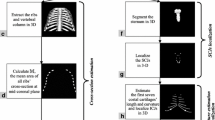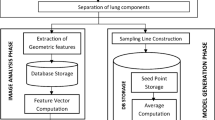Abstract
Purpose
The thoracic diaphragm separates the thorax and abdomen cavity and also performs an important function in respiration. An automatic algorithm to model the human full diaphragm from multi-detector computed tomography (MDCT) images has been developed and tested.
Method
The modelling algorithm comprises these steps: (i) diaphragm top boundary estimation (ii) diaphragm side boundary estimation and (iii) full diaphragm modelling in 3D. Diaphragm top boundary is estimated based on lungs’ diaphragmatic surfaces with three different methods including: linear interpolation and fitting fourth and fifth degree polynomial surfaces. Diaphragm side boundary is assumed as the inner surfaces of the lower ribs, spinal column and costal cartilages, estimated via interpolation. As the last step, the full diaphragm is modelled by employing 3D active contours that are initiated from a predefined mesh and expand towards the estimated boundaries of the diaphragm. The proposed algorithm was tested on MDCT datasets from 15 patients, and the result were compared to reference masks provided by an experienced radiologist.
Results
Based on quantitative evaluations, the accuracy of the algorithm highly depends on the diaphragm top surface estimation, e.g., the proposed algorithm failed on two datasets, both with enlarged pericardial fat pad that cuts off the left lung from the diaphragm. The proposed algorithm was tested on the remaining 13 datasets in which lungs’ lower surfaces have normal contact with the diaphragm. To perform quantitative evaluations, four slices per dataset including an axial, mid-coronal and one-fourth of the sagittal planes from left and right, were compared to the ground truth. Hausdorff distance and mean distance to the closest point were measured to be 11.61 and 3.46 mm respectively, when the diaphragm top surface is modelled by a fourth degree polynomial surface.
Conclusion
Human full diaphragm can be automatically modelled with 3D active contours bounded by the lower surfaces of the lungs and inner surfaces of the lower ribs, spinal column and costal cartilages.









Similar content being viewed by others
References
Diaphragm @ONLINE (2013). http://www.healthcentral.com/acid-reflux/19072-146.html
Sharif Al S, Deriche M, Maalej N, El Ferik S (2014) A fast geodesic active contour model for medical image segmentation using prior analysis and wavelets. Arab J Sci Eng 39(2):1017–1037. doi:10.1007/s13369-013-0664-4
Behr M, Thollon L, Arnoux P, Serre T, Berdah S, Baque P, Brunet C (2006) 3d reconstruction of the diaphragm for virtual traumatology. Surg Radiol Anat 28(3):235–240
Beichel R, Bischof H, Leberl F, Sonka M (2005) Robust active appearance models and their application to medical image analysis. Med Imaging IEEE Trans 24(9):1151–1169
Beichel R, Gotschuli G, Sorantin E, Leberl F, Sonka M (2002) Diaphragm dome surface segmentation in ct data sets: a 3d active appearance model approach. In: SPIE proceedings of the medical imaging 2002 (4684):475–484
Beichel R, Mitchell S, Sorantin E, Leberl F, Goshtasby A, Sonka M (2001) Shape and appearance based segmentation of volumetric medical images. In: Proceedings 2001 international conference on image processing, vol 2, pp 589–592
Boykov Y, Funka-Lea G (2006) Graph cuts and efficient n-d image segmentation. Int J Comput Vis 70(2):109–131
Caselles V, Catt F, Coll T, Dibos F (1993) A geometric model for active contours in image processing. Numer Math 66:1–31
Caselles V, Kimmel R, Sapiro G (1995) Geodesic active contours. In: Proceedings of fifth international conference on computer vision, pp 694 –699
Chen M, Bai J, Siochi R (2013) A new method of diaphragm apex motion detection from 2d projection images of mega-voltage cone beam ct. Phys Med Biol 58(3):715–733
Gray H, Warren Harmin L (2000) Anatomy of the human body, 20th edn. Lea and Febiger, Bartleby, Philadelphia
Huttenlocher D, Klanderman G, Rucklidge W (1993) Comparing images using the hausdorff distance. Pattern Anal Mach Intell IEEE Trans 15(9):850–863
Huttenlocher DP, Kedem K (1990) Computing the minimum hausdorff distance for point sets under translation. In: Proceedings of the sixth annual symposium on computational geometry, SCG ’90ACM, New York, NY, USA, pp 340–349
Kang L, Xiaodong W, Chen D, Sonka M (2006) Optimal surface segmentation in volumetric images-a graph-theoretic approach. Pattern Anal Mach Intell IEEE Trans 28(1):119–134
Kass M, Witkin A, Terzopoulos D (1988) Snakes: active contour models. Int J Comput Vis 1:321–331
Ladjal H, Saade J, Beuve M, Azencot J, Moreau JM, Shariat B (2013) 3d biomechanical modeling of the human diaphragm based on ct scan images. In: Long M (ed) World congress on medical physics and biomedical engineering May 26–31, 2012, Beijing, China, IFMBE Proceedings, vol 39. Springer, Berlin Heidelberg, pp 2188–2191
Li X, Wang X, Dai Y ((2014)) Robust global minimization of active contour model for multi-object medical image segmentation. In: Instrumentation and measurement technology conference (I2MTC) proceedings, 2014 IEEE international, pp 1443–1448 . doi:10.1109/I2MTC.2014.6860984
Lrig C, Kobbelt L, Ertl T (2000) Hierarchical solutions for the deformable surface problem in visualization. Graph Models 62:1–18
Martin S, Dey J, King M, Hutton B (2007) Segmenting and tracking diaphragm and heart regions in gated-ct datasets as an aid to developing a predictive model for respiratory motion-correction. In: Nuclear science symposium conference record, 2007. NSS ’07. IEEE, vol 4, pp 2680–2685
McClelland J, Hawkes D, Schaeffter T, King A (2013) Respiratory motion models: a review. Med Image Anal 17(1):19–42
McQuaid S, Lambrou T, Cunningham V, Bettinardi V, Gilardi MC, Hutton B (2009) The application of a statistical shape model to diaphragm tracking in respiratory-gated cardiac pet images. In: Proceedings of the IEEE 97(12):2039–2052
McQuaid S, Lambrou T, Hutton B (2011) A novel method for incorporating respiratory-matched attenuation correction in the motion correction of cardiac petct studies. Phys Med Biol 56(10):2039–2052
Pato M, Santos N, Areias P, Pires E, de Carvalho M, Pinto S, Lopes D (2011) Finite element studies of the mechanical behaviour of the diaphragm in normal and pathological cases. Comput Methods Biomech Biomed Eng 14(6):505–513
Pazokifard B, Sowmya A. (2013) 3-d segmentation of human sternum in lung mdct images. In: Engineering in medicine and biology society (EMBC), 2013 35th annual international conference of the IEEE, pp 3351–3354. doi:10.1109/EMBC.2013.6610259
Pazokifard B, Sowmya A (2013) Efficient graph cuts based extraction of vertebral column and ribs in lung mdct images. In: 2013 20th IEEE international conference on image processing (ICIP), pp 1182–1186. doi:10.1109/ICIP.2013.6738244
Pazokifard B, Sowmya A (2013) Lung segmentation with graph cuts: graph size versus performance. In: AIP conference proceedings 1559(1):315–322
Pazokifard B, Sowmya A, Moses D (2014) Automatic patient-customised 3d reconstruction of human costal cartilage from lung mdct dataset. Int J Comput Assist Radiol Surg pp 1–8. doi:10.1007/s11548-014-1086-9
Petkov S, Carrillo X, Radeva P, Gatta C (2014) Diaphragm border detection in coronary x-ray angiographies: new method and applications. Comput Med Imaging Graph 38(4):296–305
Rangayyan R, Banik S, Boag G (2009) Landmarking and segmentation of computed tomographic images of pediatric patients with neuroblastoma. Int J Comput Assist Radiol Surg 4(3):245–262
Rangayyan R, Vu R, Boag G (2008) Automatic delineation of the diaphragm in computed tomographic images. J Digit Imaging 21(1):134–147
Shuai Z, Yanjun P (2012) 3d medical image segmentation based on active contour model. In: 2012 5th international conference on biomedical engineering and informatics (BMEI), pp 98–102 . doi:10.1109/BMEI.2012.6512895
Terzopoulos D, Witkin A, Kass M (1987) Symmetry-seeking models and 3d object reconstruction. Int J Comput Vis 1:211–221
Vedam SS, Kini VR, Keall PJ, Ramakrishnan V, Mostafavi H, Mohan R (2003) Quantifying the predictability of diaphragm motion during respiration with a noninvasive external marker. Med Phys 30(4):505–513
Vidal F, Villard PF, Lutton E (2012) Tuning of patient-specific deformable models using an adaptive evolutionary optimization strategy. Biomed Eng IEEE Trans 59(10):2942–2949
Villard P, Bourne W, Bello F (2008) Modelling organ deformation using mass-springs and tensional integrity. In: Bello F, Edwards P (eds) Biomedical Simulation. (Lecture Notes in computer science), Springer, Berlin, vol 5104, pp 221–226
Vostatek P, Novak D, Rychnovskyy T, Wild J (2010) Diaphragm postural function analysis using magnetic resonance. In: 2010 10th IEEE international conference on information technology and applications in biomedicine (ITAB), pp 1–4 (2010)
Wang X, Wang Q, Hao Z, Xu K, Guo P, Ren H, Jang W, Kim Jb (2014) Real-time 3d medical structure segmentation using fast evolving active contours. doi:10.1117/12.2042974
Yalamanchili R, Chittajallu D, Balanca P, Tamarappoo B, Berman D, Dey D, Kakadiaris I (2010) Automatic segmentation of the diaphragm in non-contrast ct images. In: 2010 IEEE international symposium on biomedical imaging: from nano to macro, pp 900–903
Zhou X, Ninomiya H, Hara T, Fujita H, Yokoyama R, Chen H, Kiryu T, Hoshi H (2008) Automated estimation of the upper surface of the diaphragm in 3-d ct images. Biomed Eng IEEE Trans 55(1):351–353
Author information
Authors and Affiliations
Corresponding author
Ethics declarations
Conflict of interest
Banafsheh Pazokifard, Arcot Sowmya, and Daniel Moses declare that they have no conflict of interest.
Appendices
Appendix 1
Followings are pseudocode for merging and unifying the diaphragm top and side boundaries:

Appendix 2
Followings are pseudocode for removing diaphragmatic irrelevant voxels from unified diaphragm top and side boundaries:

Rights and permissions
About this article
Cite this article
Pazokifard, B., Sowmya, A. & Moses, D. Automatic 3D modelling of human diaphragm from lung MDCT images. Int J CARS 11, 767–776 (2016). https://doi.org/10.1007/s11548-015-1298-7
Received:
Accepted:
Published:
Issue Date:
DOI: https://doi.org/10.1007/s11548-015-1298-7




